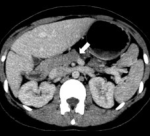Annular pancreas is an uncommon congenital anomaly characterized by encasement of the duodenum by a band of pancreatic tissue.
What is the Pathology an Annular Pancreas?
The pathology of annular pancreas is:
-Etiology: The cause of annular pancreas is well understood, linked to the embryological anomaly. One portion of the ventral pancreatic primordium becomes static, while the other part of primordium is drawn around the duodenum.
-Genes involved: Transmembrane 4 superfamily member 3 (tm4sf3)
-Pathogenesis: The sequence of events that lead to annular pancreas is anticipated to be a migration anomaly ensuing from ventral bud failure to rotate and extend to sheath the second portion of the duodenum partially or completely.
-Morphology: The morphology associated with annular pancreas shows it can be divided into intramural and extramural types grounded on the existence of pancreatic tissue in the duodenal wall.
-Histology: The histology associated with annular pancreas shows numerous pancreatic polypeptide (PP) cells of ventral pancreatic anlage organized in sporadically shaped islets.
How does an Annular Pancreas Present?
Patients with annular pancreas typically have a slight male preponderance present at age range of infancy to adulthood. The symptoms, features, and clinical findings associated with annular pancreas include non-bilious vomiting, feeding intolerance, and bloating, in infants. Duodenal obstruction, pancreatitis, and abdominal pain in adults.
How is an Annular Pancreas Diagnosed?
Annular pancreas is diagnosed through radiological(CT scan, MRI, magnetic resonance cholangiopancreatography (MRCP)) and clinical manifestations.
How is an Annular Pancreas Treated?
Annular pancreas is treated through individual management of the symptoms, surgical management (duodenal bypass procedures) commonly in children.
What is the Prognosis of an Annular Pancreas?
The prognosis of annular pancreas is good in children with overall survival rates and is fair in adults.



